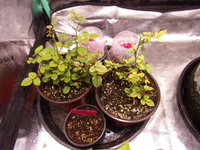LiquidSkin
Yamadori
Hello all and welcome to my indoor garden.
I grow bonsai indoors under lights because I live in an apartment with no outdoor garden space also my windows are north facing. Yet I love bonsai and gardening in general so I bought a silver reflective greenhouse tent thing from ebay and some 55w led lights to garden with. Currently I am growing 1 Everbearing Mulberry, two unknown Roses claimed to be Micro Miniature class, and have just the other day ordered a common dwarf Myrtle communis. I haven't received the Myrtle yet though it is in transit. I also have a Lunchbox Pepper and Dwarf Firecracker Pepper that will be grown into a Bonchi eventually. The Lunchbox was purchased from Walmart as a starter plant and Firecracker started from seed. Other things growing from seed are two Angel Wings Heirloom Miniature Rose.
Everything was growing well until I received the first rose from etsy. This rose had spider mites which spread to the mulberry resulting in a need to spray with pyrethrin, this caused the rose and mulberry to defoliate. Then I found another rose I wanted and ordered it, again it had spider mites which spread to the Mulberry and first rose. I sprayed pyrethrin and they defoliated again. This time I swore off ordering online. Hopefully the Myrtle wont have spider mites because I don't think the Mulberry will survive another defoliation. As is there is die back.
Here in this thread I will document all Bonsai and indoor gardening progression over the years.
The Greenhouse

Everbearing Mulberry I'm not sure why only one side is growing. There are a couple green buds developing on the bear side though. It is planted in a 5 gallon pot to grow tall and thicken the trunk and produce fruit.

Micro Roses

Lunchbox Pepper

I grow bonsai indoors under lights because I live in an apartment with no outdoor garden space also my windows are north facing. Yet I love bonsai and gardening in general so I bought a silver reflective greenhouse tent thing from ebay and some 55w led lights to garden with. Currently I am growing 1 Everbearing Mulberry, two unknown Roses claimed to be Micro Miniature class, and have just the other day ordered a common dwarf Myrtle communis. I haven't received the Myrtle yet though it is in transit. I also have a Lunchbox Pepper and Dwarf Firecracker Pepper that will be grown into a Bonchi eventually. The Lunchbox was purchased from Walmart as a starter plant and Firecracker started from seed. Other things growing from seed are two Angel Wings Heirloom Miniature Rose.
Everything was growing well until I received the first rose from etsy. This rose had spider mites which spread to the mulberry resulting in a need to spray with pyrethrin, this caused the rose and mulberry to defoliate. Then I found another rose I wanted and ordered it, again it had spider mites which spread to the Mulberry and first rose. I sprayed pyrethrin and they defoliated again. This time I swore off ordering online. Hopefully the Myrtle wont have spider mites because I don't think the Mulberry will survive another defoliation. As is there is die back.
Here in this thread I will document all Bonsai and indoor gardening progression over the years.
The Greenhouse

Everbearing Mulberry I'm not sure why only one side is growing. There are a couple green buds developing on the bear side though. It is planted in a 5 gallon pot to grow tall and thicken the trunk and produce fruit.

Micro Roses

Lunchbox Pepper

Last edited:









